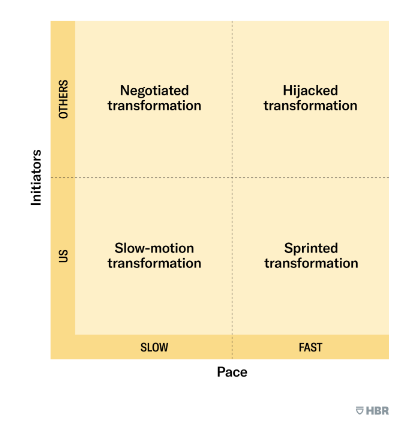
A new study published in Harvard Business Review highlights four types of business transformation, providing further clarity for business leaders who are aiming to transition.
Business transformations are highly variable, depending on the needs of the organization and the time they have to transition. As such, there is not a one-fits-all strategy for how to navigate a transformation, and business leaders need to be aware of the unique challenges their organization faces.
Copenhagen Business School Professor Thomas Ritter and IT University of Copenhagen Associate Professor Carsten Lund Pedersen have developed a typology for business leaders for clarity on the four different types of business transformation.
SEE ALSO: How Businesses Can Integrate Natural Language Processing
“Business transformations can take many forms and often occur at the same time,” said Ritter and Pedersen in a Harvard Business Review article. “To understand which approach you’ll need to take, ask yourself two questions: 1) Is your transformation driven by internal needs or external forces? 2) Does it need to happen quickly, or do you have more time to transform?”

Slow-motion transformation
A slow-motion transformation is implemented over a long period of time with managerial and cultural changes happening over several years or a decade. Businesses conducting this type of transformation have plenty of time to oversee the various changes to operations, which should, in theory, enable them to make more astute decisions on the path forward, although that is not always the case.
Microsoft transformation since CEO Satya Nadella was installed in 2014 may be considered a slow-motion transformation. Under Nadella’s guidance the culture at Microsoft has changed significantly, shifting away from the hardball negotiation tactics and rejection of open-source technologies that Microsoft was known for pre-Nadella.
Businesses aiming for a slow-motion transformation need to have a long-term view of the future and patience, even if things don’t fall into place at once.
Sprinted transformation
While a slow-motion transformation can provide security for the executive team and business by taking things one step at a time and discussing each change with stakeholders, some business leaders may want a faster transition to surpass competitors or claim a first-mover advantage.
That was the case with Meta Platforms transformation in 2021, previously known as Facebook. CEO Mark Zuckerberg announced the name change in October 2021, and quickly got the memo out that virtual and augmented reality were the key areas of focus for the next few years. Internally, workers were told to apply for new jobs in these fields, while also stating they would hire 10,000 metaverse workers in Europe.
Zuckerberg’s shift has been considered by some to be impractical and more of a deterrent against bad press than a long-term view, however, it has pushed Meta Platforms firmly into the driving seat when it comes to metaverse development.
Negotiated transformation
A negotiated transformation is a long-term response to external demands, typically changes in national or international laws that require internal adjustments to an organization or its content. These take place over several years and businesses of influence are able to negotiate the new rules, and work with those crafting the rules to ensure as minimal disruption as possible.
The European Union’s GDPR is referenced by Ritter and Pedersen as a time when several businesses, including global publishers, were in a negotiated transformation with the EU. Since enacting the law, the EU has listened to some of the demands of publishers and others businesses in regards to updating the law, to make websites based in the US and other countries operable in the EU.
Hijacked transformation
Sometimes, when dealing with a national or international legislative body, there is no recourse from the decisions made by the legislature. This is considered a hijacked transformation, where an organization must quickly deal with external issues and align the business with new realities.
As seen with the US-China trade war, organizations were given a short amount of time to remove all Huawei products from their infrastructure, or face heavy fines for breaking trading laws. Almost all businesses that operate in the US and Europe quickly removed Huawei infrastructure.
When Russia invaded Ukraine, many Ukrainian businesses were forced into a hijacked transformation, having to quickly adjust to the new realities by removing their employees from the country. Businesses that worked with Russian-based companies had to quickly end partnerships, or face repercussions.




























